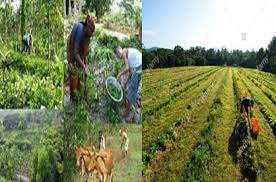Mixed farming: Crops are harvested and animals are raised as part of mixed farming. The virus spread across Asia as well as nations such as India, Afghanistan, South Africa, Malaysia, Indonesia, China, Canada, Central Europe, and Russia. It is primarily used domestically in some nations. In the United States and Japan, it is currently used for business purposes. Essentially, mixed cultivation consists of the breeding of animals for meat, eggs, or milk as well as the development of yields.
Types of Mixed Farming
Mixed farming can be classified into eight types. Check it out.
1. Subsistence Farming
Farming for subsistence means harvesting food to meet the needs of a family on a small holding, almost without excess. It focuses on farm yield for endurance and generally nearby needs, with almost no excess.
2. Shifting Agriculture
Changing Agriculture involves developing plots of land quickly. After the unsettling influence, the cultivator continued on to another plot while neglected vegetation developed unreservedly.
3. Plantation Agriculture
A plantation is a business that produces a single crop all year long. It takes a lot of time and money to cultivate this kind of crop. In addition, the yield creation might also be handled on the farm where it is produced or in neighboring production lines.
4. Intensive Farming
The intensive farming process is something of an agribusiness, both in plant and animal production, with higher levels of data and results per unit of agricultural land. This can be termed Intensive cultivation, traditional farming, or modern farming, in addition to conventional farming.
5. Dry Agriculture
The dryland cultivation and agriculture of the dryland include methods for developing harvests without water. The practice of dryland farming is related to the conditions of drylands, which are characterized by alternating cool, wet seasons and warm, dry seasons. Additionally, they occur in bone-dry conditions, in areas prone to dry spells, and in areas with limited water supplies.
6. Mixed and Multiple Agriculture
The practice of growing at least two yields in a similar area during one growing season is known as mixed agriculture or multicropping in horticulture. Intercropping occurs when several yields are developed simultaneously. Farmer’s harvest efficiency and income are multiplied with the help of this editing framework.
7. Crop Rotation
Crop rotation refers to the practice of establishing multiple harvests consecutively in a similar plot of land to enhance soil wellbeing, reduce weed pressure, and streamline supplements in the soil. There may be a few harvests during a short rotation, but at least twelve during a complex rotation.
8. Terrace Cultivation
Globally, terrace cultivation encompasses a variety of “steps” that are created in different locations. The method of cultivating farmers uses “steps” incorporated into mountains or slopes. Planting yields differ on each level. Instead of washing the supplements ceaselessly in the soil when it rains, they are conveyed upward when it rains.
Read More:How does commercial farming work? Features & Advantages
Characteristics of Mixed Farming
-
The land is used to grow crops and raise animals.
-
The animal field is a piece of land held for animal use. Farmers might choose to raise their animals in unusual structures or develop animal feed for them.
-
There are average-sized farms.
-
Grain is harvested from extra crops. Using the extra yield, the farmer can purchase animal feed and provide them with meat and milk during the year, saving some money.
-
Crops are prepared for planting with fertilizer produced by creatures. Farmers can increase their production and raise their income by raising animals, which produce fertiliser that can be applied to the land to build soil fertility.
Mixed farming benefits
Mixed farming has the following advantages. Take a look below.
-
Farmers can rely on animals when yields are low or costs change.
-
It is persistently paid to the farmers. Keeping the farmer’s wages stable over time is the goal of animal raising.
-
Pay increases. Comparing crop cultivation alone or creature raising alone, mixed earnings from crop gathering and animal products are higher.
-
Throughout the year, the farmer occupied it consistently. Farmer focusses after gathering on raising animals which guarantee a good income.
-
When extra crop is used as grain, cash can be set aside for its purchase.
-
It ensures that the harvest will be supported and reduces fertilizer expenditures by using compost from creatures.
Do you know where in India mixed farming is practiced?
Odisha and Kerala in India practice mixed crop and livestock farming. It is helpful to have a mixed crop farming framework to reduce the cost of creation per unit region, to expand pay and effectiveness, and to reduce farmers’ risks.
In this article, we will discuss mixed cropping and farming in India. I hope you have a good understanding of the advantages and disadvantages of mixed farming. Stay connected with Aarug Agro if you wish to learn more about commercial mixed farming.


